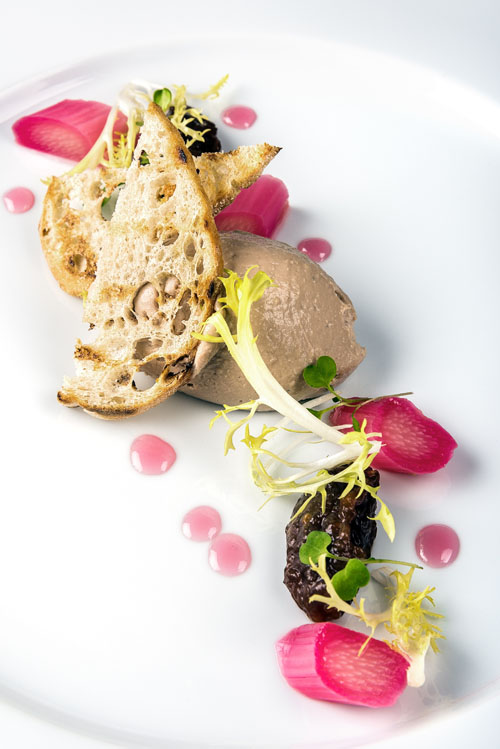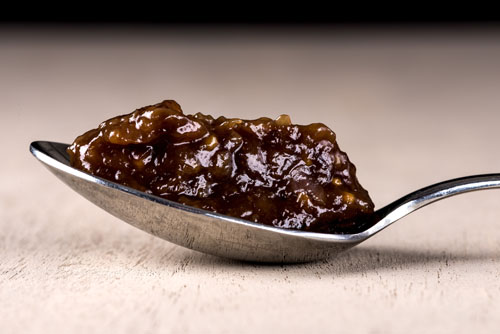Home-grown harvest: Recipes and tips for Yorkshire rhubarb
This versatile vegetable can deliver a piquant flavour to both sweet and savoury dishes, says former Sienna chef-proprietor Russell Brown
As with so many seasonal ingredients, the new season crop of Yorkshire forced rhubarb is made more desirable by its appearance at a time of year when British produce is relatively sparse.
The growers of Yorkshire forced rhubarb have had mixed fortunes across the years, and there has been a dramatic decline in production since the Second World War. Rhubarb was widely available at this time, but it was somewhat unpalatable due to the rationing of staples such as sugar. Combined with a post-war increase in the import of exotic produce, rhubarb's popularity declined.
The number of growers in the Rhubarb Triangle, between Bradford, Leeds and Wakefield, may have gone from around 200 to 11, but the market has seen a recent resurgence. In part, this is due to the award of Protected Designation of Origin (PDO) status and the efforts of the growers to promote what is a truly unique product.
The PDO application document gives a comprehensive description of every aspect of the production of Yorkshire forced rhubarb, and certainly highlights the differences between this and other forcing methods. The Rhubarb Triangle is situated in a natural frost pocket, where the Pennines provide high rainfall and the wool industry generates a waste product known as shoddy, which is used along with animal manure as a nitrogen-rich, slow-release fertiliser. In the past, the availability of coal in the region and good rail links were also vital.
The rhubarb roots need to contain a certain amount of glucose before they are lifted and moved to the forcing sheds. The ground temperatures are recorded to determine when enough ‘cold units' have been accumulated, and therefore enough carbohydrate has been converted to glucose to generate a good crop.
At this stage, the roots are around two years old and can weigh up to 50 kilos. They are carefully lifted and transferred to specially prepared beds in the forcing sheds. Here, heat is used to stimulate petiole, or stalk, growth. Candlelight is used for harvesting to prevent photosynthesis, which thickens and toughens the fibres in the stems as well as increasing acidity. This process is vastly different from that used by many Dutch growers, who rely on cold storage followed by the application of gibberellic acid to achieve the necessary glucose levels.
Rhubarb is a vegetable that traditionally has been treated more as a fruit in sweet dishes, but on modern menus it easily straddles the line between sweet and savoury. A good illustration of this is a dish from Ernst Van Zyl at the Lord Clyde in Kerridge, who uses various preparations of rhubarb with white chocolate, natural yogurt and a Blacksticks Blue cheese crumble.
Other ideas come from head chef Eddy Rains at the Wheatsheaf in Combe Hay near Bath, and include a lemon and stem ginger cheesecake with rhubarb sorbet, and rhubarb puréed with fresh ginger to accompany charred mackerel.
Cooking rhubarb sous vide is a popular method and ensures good, consistent results, with the right balance between firmness and tenderness.
Buying and storage tips
- Check for PDO status to ensure your rhubarb is Yorkshire forced rhubarb.
- The stems should be crisp and firm.
- Rhubarb can be stored in a refrigerator for up to a week.
- Rhubarb is excellent in jams, chutneys, pickles and syrups.
- Rhubarb can be frozen as a purée or as a strained juice for syrups and sorbet.
Recipe: rhubarb pickle
- 150ml cider vinegar
- 150ml white wine
- 150g caster sugar
- 2 bay leaves
- 2 sprigs of thyme
- 6 whole peppercorns
- 1 tsp yellow mustard seeds
- 400g Yorkshire forced rhubarb, trimmed, washed and cut into 10cm lengths
Serve the pickle and chutney (below) as an accompaniment to duck liver parfait, pork rillettes or ham hock terrine. The pickled rhubarb also works well gently warmed with pork belly.
Recipe: rhubarb chutney
- 1dsp olive oil
- 300g half red onion, half white, diced
- 2 garlic cloves, minced
- 1tsp yellow mustard seeds
- 1tsp ground ginger
- 400g rhubarb, finely chopped
- 100ml red wine vinegar
- 100g light muscovado sugar
- Maldon sea salt and fresh black pepper
Heat the oil in a heavy-based pan and sweat the onion and garlic until soft. Add the spices and cook out, stirring for one minute. Add the remaining ingredients except the salt and pepper.
Cook over a medium heat until the chutney is reduced and thick. Season to taste and adjust the sweet/sour balance with a little extra vinegar or sugar as required.
Chill a small sample to taste and make further adjustments if required. Transfer to sterile jars while still hot.
Recipe: rhubarb and almond tart
Serves 8-10
For the rhubarb
- 200g forced rhubarb
- 25g caster sugar
- 25ml ginger wine
For the frangipane (makes enough for one 26cm tart serving 10 portions, or eight individual tarts)
- 150g unsalted butter
- 150g caster sugar
- 150g whole Blackacre farm egg
- 50g self-raising flour
- 150g ground almonds
- 5g salt
- A few drops almond extract
For the sweet pastry (makes enough for four x 26cm tarts. This pastry freezes well)
- 225g unsalted butter
- 170g caster sugar
- 4 Blackacre farm egg yolks
- 4tbs cold water
- 110g cornflour
- 335g soft plain flour
- 5g Maldon salt, fine ground
Cut the rhubarb into 2cm lengths, place on a baking tray and sprinkle over the sugar and ginger wine. Roast at 160°C for two minutes until the rhubarb just starts to soften. Drain off any juice from the tray and then chill the rhubarb. Alternatively, vacuum-pack the rhubarb with the wine and sugar and cook at 62°C for 20 to 30 minutes, according to thickness.
To make the frangipane, cream the butter and sugar in a mixer. Gradually add the egg, interspersed with the flour, and then add the ground almonds and salt. Flavour with a few drops of good quality bitter almond extract.
For the pastry, cream the butter and caster sugar and beat until the mixture starts to go pale. Combine the egg yolks and the water and beat gradually into the butter mix. Mix the flours and the salt and sift onto the butter mix. Use a rubber spatula to fold the flour in - you are aiming for dough that is homogenous but has been worked as little as possible. Turn the dough onto a floured surface and bring together into a cylinder. Wrap in clingfilm and chill for at least 30 minutes.
Line a 26cm flan ring and blind bake at 160°C until just set. Remove the baking beans and cook until a light golden brown. Brush the pastry case with a yolk and water egg wash, and return to the oven for one minute. Repeat for the other tart shells.
To assemble the tart, start in the centre and pipe a thick spiral of frangipane. Push the rhubarb pieces into the frangipane, starting in the centre and working outwards. Leave around a ½cm gap between the rhubarb pieces and finish 1cm in from the edge of the pastry case. Bake at 160°C for 15-20 minutes until golden and firm. Allow to cool but do not refrigerate.
Seasonal forecast
The rhubarb season usually starts in early January and finishes in mid-April. Expect to pay £5-£6 per kilo for Class 1 and a third less for the thinner, paler Class 2. Supplies of Class 2 are rather sporadic. The faux forced rhubarb from growers outside of the Rhubarb Triangle (which are blanched but soil grown without proper forcing) is about a pound a kilo cheaper, but clearly isn't as good.
Charlie Hickswww.totalproducelocal.co.uk
Russell Brown
Russell Brown ran the Michelin-starred, three-AA-rosette Sienna restaurant in Dorchester, Dorset, for 12 years with his wife Eléna. He launched his website and consultancy business Creative about Cuisine earlier this year. He specialises in restaurant consultancy and photography.
*Are you looking for a new role? See all the current hospitality vacancies available with The Caterer* Jobs >>
Latest video from The Caterer
Continue reading
You need to be a premium member to view this. Subscribe from just 99p per week.
Already subscribed? Log In















